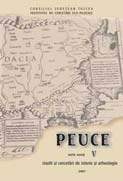Evul mediu timpuriu în Dobrogea. Date privind stadiul cercetărilor de la Ostrov–Piatra Frecăţei (jud. Tulcea)
The Early Middle Age in Dobrudja. Information Regarding the Research Level from Ostrov–Piatra Frecăţei (Tulcea County)
Author(s): Cristina Paraschiv-Talmaţchi, Aurel StănicăSubject(s): Archaeology
Published by: Institutul de Cercetari Eco-Muzeale Tulcea - Institutul de Istorie si Arheologie
Keywords: Ostrov–Piatra Frecăţei; potter’s marks; 10th –12th centuries; mărci de olar; secolele X – XII
Summary/Abstract: Included into the Dobrudjan archaeological repertory as early as the end of the 19th century, the settlement placed on the promontory of Piatra Frecăţei (located at about 2,5 kilometres from the village of Ostrov) would have, in the course of time, several stages of research, in which the attention of the specialists has been directed to the evolution of the entire site, or towards auxiliary procedures (the study of the archaeo-zoological material, geophysical, magnetic and experimental electrical prospects), with a remarkable contribution to the completion of the archaeological – historical data. In Piatra Frecăţei, we have found traces of the prehistoric era (belonging to the Hamangia culture and to the Bronze Age), of the Geto-Dacian civilization, of the Roman period, of the Roman-Byzantine period, and of the early medieval period. The archaeological excavations, initially with a salvaging character, undertaken during the interval 1958 - 1976, on a plateau that was located towards the north-east, in the immediate vicinity of the fortified area, have led to the identification of 1139 graves (dated to the 2nd – 7th and 10th – 12th centuries). The investigations that were undertaken in the civil settlement have unearthed three levels of habitation: one that lasted until the end of the 6th century AD and two successive ones, dated to the 10th – 12th centuries. Finally, our attention is drawn to a batch of 23 vessel bottoms, dated to the 11th – 12th centuries, which display potter’s marks, rendered in relief, or signs whose position or shape seem to suggest that they represent vestigial parts of a mark, depending on the extant surface of the container’s flat area (the description of the pieces contains data about the year of discovery, the position within the site, the type of baking of the vessel, the paste, the portrayal of the sign and further technical information).
Journal: Peuce (Serie Nouă) - Studii şi cercetari de istorie şi arheologie
- Issue Year: V/2007
- Issue No: 5
- Page Range: 313-334
- Page Count: 22
- Language: Romanian

